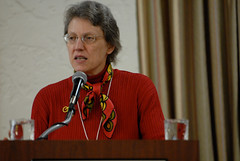The Oregon Transportation Commission is like the Jedi Council when it comes to setting statewide transportation policy. Its members are appointed by the governor and they have tremendous influence over funding, setting direction and priorities, and a host of other decisions that have a direct impact on our state’s transportation system.
With Oregon on an exciting biking trajectory, it occurred to me that all our momentum could be stifled if ODOT (whom the OTC sets policy direction for) is not ready to handle it.
In other words, imagine a funnel with all the projects, programs and great ideas for biking at the top, and a very small hole on the bottom. The hole is ODOT.
“I’m all for a bike path that goes from Klamath Falls to Bly but that’s not where most of the users are. We need to have an integrated look at what we are investing in.”
— Gail Achterman, Chair, Oregon Transportation Commission
Here’s why: ODOT currently has one person two people on their entire 4,500-plus person staff fully devoted to managing biking and walking projects: Sheila Lyons (statewide) and Basil Christopher (Region 1).
That’s a lot of work for for two people and it means that bike projects and other non-motorized initiatives lag. I’ve mentioned this in meetings and privately to many people over the years and now it seems like there’s movement from within ODOT to do something about it.
Turns out that the Chair of the OTC, Gail Achterman, along with Lyons and other ODOT staff, are working to remedy this situation. Several notable recent decisions by the OTC may set a new course for the future of ODOT and active transportation in our state.
I spoke with Achterman about this via phone recently and she detailed three things they’re working on that I’m excited to share.
- Oregon Bike Summit
Friday, June 4th
World Trade Center, Portland
Achterman says the OTC has been working with ODOT staffers to scour every project funding source that can be used for trail and other projects outside of the highway right-of-way (since gas tax revenue is constitutionally dedicated to projects in the state highway right-of-way). The result is what Achterman refers to as an “extraordinarily thought-provoking piece of analysis.”
There’s the 1% “Bicycle Bill” set-aside, federal funds for the Transportation Enhancement and Safe Routes to Schools programs, ODOT bike and pedestrian grant monies, the new Urban Trails Fund, State Parks grants, and a Recreational Trails Program.
Achterman was surprised to learn about all these funding pots. She called them “silo’d funding streams.” “It shows we’ve got dribs and drabs of money across a whole bunch of program areas.”
The funding silos were a revelation to Achterman and she wants to break them down:
“I thought, wait a second here, we ought to be making much better use of these dollars. I had no idea we get federal money that has to be passed to State Parks… I’m all for a bike path that goes from Klamath Falls to Bly but that’s not where most of the users are. We need to have an integrated look at what we are investing in… Let’s figure out what the strategic investment criteria are and what we can get accomplished.”
Achterman shared an example: Imagine improvements made to a school through the Safe Routes program. With a more integrated investment strategy, ODOT would then look to focus other capital investment dollars to build a safe biking and walking path to that school — amplifying the Safe Routes investment and creating a more connected, non-highway system.
In their most recent meeting, the OTC passed a rule that established a new Flexible Funds Advisory Committee to develop criteria to allocate (through a competitive grant program) the state’s $21.1 million in flexible funds available for the remaining biennium.
In a related move, the OTC, under Achterman’s direction, has set aside $2 million to do preliminary engineering (PE) on non-highway projects. One of the glaring issues that came up with the announcement of the federal transportation stimulus dollars is that there were simply not many biking and walking projects that had PE already completed — meaning they weren’t considered “shovel-ready” so they didn’t get funded (meanwhile, ODOT has many highway projects ready to go at a moment’s notice). Achterman hopes boosting the PE dollars for non-highway projects will allow ODOT staff to have more of them ready to go the next time a big funding opportunity comes along. “Hopefully we’ll be in a better position to compete for those dollars.”
Getting back to ODOT staffing levels, Achterman said they have seen a “tremendous appetite” across the state for biking and walking projects. A recent call for projects netted 54 applications in just one week. “You look at that and say, we don’t have the staff to put this together in a comprehensive, smart way.” Achterman said as they work on the budget for 2011-2013, she plans to ask for more staff.
To the non-wonk all this might not seem like such a big deal. But it is. As Chair of the OTC, Achterman is well-versed in the benefits of active transportation. If she can get the requisite level of support (both from the public and the ODOT bureaucracy), Oregon can make exciting new gains in biking and walking.
Achterman is slated to speak about all this and more at the Oregon Bike Summit tomorrow morning. Stay tuned.


